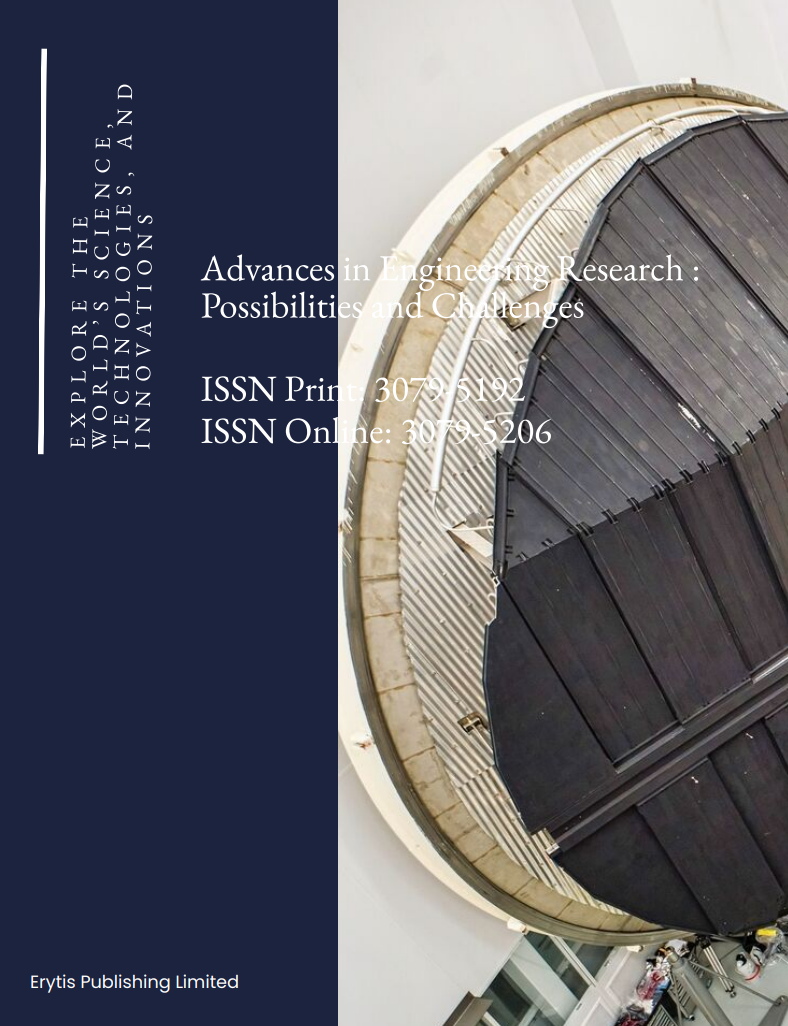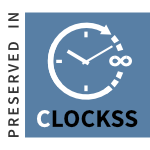Simulation of Thermal Barrier Layer Effects on Cu/PI Structures for Flexible Film Antenna Fabrication
DOI:
https://doi.org/10.63313/AERpc.9053Keywords:
Laser Ablation, Thermal Barrier Layer, Finite Element Simulation, Cu/Ti/PI Structure, Nanosecond LaserAbstract
This study investigates the influence of a thermal barrier layer on the laser ablation behavior of a Cu/Ti/PI trilayer structure using finite element simulation in COMSOL Multiphysics. A 2D model was established to analyze the temperature distribution and material removal under nanosecond pulsed laser irradiation. The effects of single-pulse energy, thermal barrier layer thickness, pulse width, and scanning speed were systematically evaluated. Results indicate that a Ti thermal barrier layer with a thickness of 200–300 nm effectively delays the vaporization of the PI substrate while maintaining adequate copper removal. Optimal processing parameters were identified as a single-pulse energy of 450 μJ, pulse width of 120 ns, and scanning speed of 250 mm/s, which achieved complete copper ablation with minimal substrate damage.
References
[1] Anwar, R., Mao, L., & Ning, H. (2018). Frequency Selective Surfaces: A Review. Applied Sci-ences, 8(9), 1689. https://doi.org/10.3390/app8091689
[2] Usmani, W. U., Chietera, F. P., & Mescia, L. (2025). Flexible Phased Antenna Arrays: A Re-view. Sensors, 25(15), 4690. https://doi.org/10.3390/s25154690
[3] Gal-Katziri, M., Fikes, A., & Hajimiri, A. (2022). Flexible active antenna arrays. Npj Flexible Electronics, 6(1). https://doi.org/10.1038/s41528-022-00218-z
[4] Dong, Z., He, Q., Shen, D., Gong, Z., Zhang, D., Zhang, W., Ono, T., & Jiang, Y. (2023). Micro-fabrication of functional polyimide films and microstructures for flexible MEMS applica-tions. Microsystems & Nanoengineering, 9(1). https://doi.org/10.1038/s41378-023-00503-5
[5] Zhang, C., He, X., & Lu, Q. (2024). High-frequency low-dielectric-loss in line-ar-backbone-structured polyimides with ester groups and ether bonds. Communications Materials, 5(1). https://doi.org/10.1038/s43246-024-00502-7
[6] Kirtania, S. G., Elger, A. W., Hasan, Md. R., Wisniewska, A., Sekhar, K., Karacolak, T., & Sekhar, P. K. (2020). Flexible Antennas: A Review. Micromachines, 11(9), 847. https://doi.org/10.3390/mi11090847
[7] Shin, B. S., Oh, J. Y., & Sohn, H. (2007). Theoretical and experimental investigations into la-ser ablation of polyimide and copper films with 355-nm Nd:YVO4 laser. Journal of Materi-als Processing Technology, 187–188, 260–263. https://doi.org/10.1016/j.jmatprotec.2006.11.106
[8] Mamleyev, E. R., Heissler, S., Nefedov, A., Weidler, P. G., Nordin, N., Kudryashov, V. V., Länge, K., MacKinnon, N., & Sharma, S. (2019). Laser-induced hierarchical carbon patterns on pol-yimide substrates for flexible urea sensors. Npj Flexible Electronics, 3(1). https://doi.org/10.1038/s41528-018-0047-8
[9] Wang, R., Gesang, D. Z., Wei, G., Yang, J. P., Hu, H., Shang, K., & Wu, G. (2024). Study on pulse laser etched interface characteristics of metal thin film/organic material structures for space antennas. Vacuum and Cryogenics, 30(5), 522–527.
[10] Linden, J., Hoch, A., Levy, A., Sakaev, I., Toker, G. B., Fogel, O., Hod, M., & Zalevsky, Z. (2022). Enhanced throughput and clean laser drilling with a sacrificial polymer layer. Optical Ma-terials Express, 12(12), 4682. https://doi.org/10.1364/ome.467696
[11] Hribar, L., Gregorčič, P., Senegačnik, M., & Jezeršek, M. (2022). The Influence of the Pro-cessing Parameters on the Laser-Ablation of Stainless Steel and Brass during the Engraving by Nanosecond Fiber Laser. Nanomaterials, 12(2), 232. https://doi.org/10.3390/nano12020232
[12] He, Z., Lei, L., Lin, S., Tian, S., Tian, W., Yu, Z., & Li, F. (2024). Metal Material Processing Using Femtosecond Lasers: Theories, Principles, and Applications. Materials, 17(14), 3386. https://doi.org/10.3390/ma17143386
[13] Deng, G., Xie, J., Ling, H., Hu, A., & Li, M. (2025). Preparation methods and performance study of high conductivity and low roughness copper platings. Plating and Finishing, 47(3), 18–25.
[14] Cahill, D. G., Ford, W. K., Goodson, K. E., Mahan, G. D., Majumdar, A., Maris, H. J., Merlin, R., & Phillpot, S. R. (2003). Nanoscale thermal transport. Journal of Applied Physics, 93(2), 793–818. https://doi.org/10.1063/1.1524305
[15] Sidambe, A. T., Tian, Y., Prangnell, P. B., & Fox, P. (2019). Effect of processing parameters on the densification, microstructure and crystallographic texture during the laser powder bed fusion of pure tungsten. International Journal of Refractory Metals and Hard Materials, 78, 254–263. https://doi.org/10.1016/j.ijrmhm.2018.10.004
[16] Lim, H. S., & Yoo, J. (2011). FEM based simulation of the pulsed laser ablation process in nanosecond fields. Journal of Mechanical Science and Technology, 25(7), 1811–1816. https://doi.org/10.1007/s12206-011-0511-z
[17] Miao, R., Wang, T., Yao, T., Hu, S., Huang, X., & Kang, Q. (2021). Experimental and numerical simulation analysis of laser paint removal of aluminum alloy. Journal of Laser Applications, 34(1). https://doi.org/10.2351/7.0000522
[18] Long, R. S., Liu, W. J., & Shang, X. F. (2007). Numerical simulation of temperature field on laser metal deposition shaping. Laser Technology, 31(4), 394–396, 430.
[19] Yang, J., Zhou, J., Sun, Q., Meng, X., Guo, Z., & Zhu, M. (2021). Digital analysis and prediction of the topography after pulsed laser paint stripping. Journal of Manufacturing Processes, 62, 685–694.
[20] Yang, T. (2022). Simulation study and experimental verification of laser surface removal of carbon fiber composites [Master's thesis, Civil Aviation Flight School of China].
[21] Gao, L., Zhou, J., Sun, Q., Li, H., Zhu, M., Guo, Z., & Yang, J. (2019). Numerical simulation and surface morphology of laser-cleaned aluminum alloy paint layer. Chinese Journal of Lasers, 46(5), 0502002.
[22] Kim, Y. W. (2002). Thermal Diffusivity Measurement for Titanium Thin Films on Copper Substrate by Laser Produced Plasmas. International Journal of Thermophysics, 23(4), 1091–1101. https://doi.org/10.1023/a:1016346221082
[23] Kim, B., Nam, H. K., Watanabe, S., Park, S., Kim, Y., Kim, Y.-J., Fushinobu, K., & Kim, S.-W. (2020). Selective Laser Ablation of Metal Thin Films Using Ultrashort Pulses. International Journal of Precision Engineering and Manufacturing-Green Technology, 8(3), 771–782. https://doi.org/10.1007/s40684-020-00272-w
[24] Tsibidis, G. D. (2014). Thermal response of double-layered metal films after ultrashort pulsed laser irradiation: the role of nonthermal electron dynamics. arXiv. https://doi.org/10.48550/ARXIV.1402.1274
[25] Chiang, D., Tseng, S. F., Hsiao, W. T., & Hsiao, C. N. (2012). Temperature profile of the mul-tilayer structure irradiated by pulsed laser. Applied Physics A, 110(3), 571–578. https://doi.org/10.1007/s00339-012-7129-6
[26] Hong, J., Cheng, P., Guo, J., Chen, W., Li, Y., Liu, J., Zhu, Q., & Chen, J. (2023). The mechanism study of laser peeling of ultra-thin polyimide film from the transparent substrate. Surfaces and Interfaces, 36, 102561. https://doi.org/10.1016/j.surfin.2022.102561
[27] Jasim, H. A., Demir, A. G., Previtali, B., & Taha, Z. A. (2017). Process development and mon-itoring in stripping of a highly transparent polymeric paint with ns-pulsed fiber laser. Op-tics & Laser Technology, 93, 60–66. https://doi.org/10.1016/j.optlastec.2017.01.031
[28] Wang, R., Wang, Y., Yang, Y., Zhang, S., Liu, Y., Yao, J., & Zhang, W. (2023). A Systematic Study on the Processing Strategy in Femtosecond Laser Scribing via a Two-Temperature Model. Materials, 16(21), 6895. https://doi.org/10.3390/ma16216895
[29] Moskal, D., Martan, J., & Honner, M. (2023). Scanning Strategies in Laser Surface Texturing: A Review. Micromachines, 14(6), 1241. https://doi.org/10.3390/mi14061241
Downloads
Published
Issue
Section
License
Copyright (c) 2025 by author(s) and Erytis Publishing Limited.

This work is licensed under a Creative Commons Attribution 4.0 International License.















